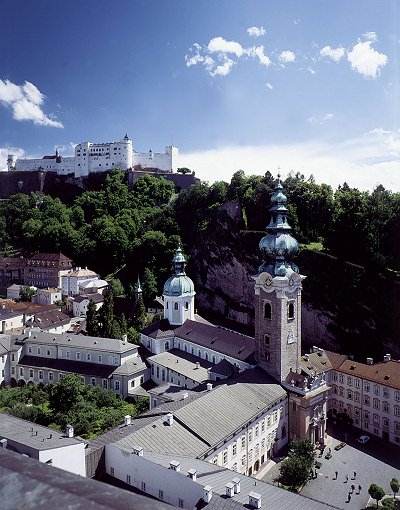S & H Festival Review
Salzburg Festival 2003: Mozart Mass in C Minor: Soloists, Mozarteum Orchester Salzburg, Choir of Clare College, dir. Ivor Bolton. 19th August 2003 (ME)
The C Minor Mass has been a feature of every Salzburg Festival since 1927, performed in the wondrous surroundings of St. Peter’s Church, and no more moving environment for this music can possibly be imagined than this glorious Romanesque abbey upon which the Baroque has been so intricately superimposed: it is especially moving, of course, given the fact that this was the venue for the first ever ‘complete’ performance of the work, in 1783 in the presence of the composer, who may have played the organ continuo. Gathering in the courtyard in anticipation we find the cream of European musical society, nearly all of them conforming to what I now see as the Austrian Festival Stereotype: that is, extraordinarily well dressed (I swear I was the only one not wearing Prada, apart from the ladies in National Costume) deeply tanned to the point of looking like bronze saddles, agonizingly slender, mostly over 55, and mostly heavy smokers. How do they look like this, one has to wonder, when they so clearly have spent whole lifetimes exposed to two of the major carcinogens? Maybe they’ll all drop dead next week, one uncharitably speculates – but somehow I doubt it. After all, they need to join the pilgrimage to the next shrine, that of Schwarzenberg for the Schubertiade.
The Pradettes having processed into the spectacular interior, it’s interesting how many of them don’t quite seem to know what those big stone bowls by the door are for, considering that an astonishing 80% of Salzburg’s population is Catholic: so moving was the whole thing, however, what with the sight of the rococo embellishments, the intensely emotional paintings and the faint whiff of incense, that your correspondent found herself transported back to her (gruesome) Catholic youth, and actually dipped her hand in the water and made ‘The Sign.’ Many ‘Grüss Gott’ mutterings later, she settled down amidst the silk and leather to hear… well, certainly a pleasing account of the piece, but not exactly a tremendous musical feast. I’m told that this is so ‘standard’ a part of the Festival that ‘they just round up whoever they can to do it’ (whatever that means) and it certainly had the feel of a somewhat patchy ensemble.
The Choir of Clare College was the glory of this evening, singing with that earthy rather than ethereal sound which seems to characterize work prepared by Timothy Brown, and what a refreshing sound it is: for once, the Credo actually sounded like a passionate affirmation of belief, and the wonderful double fugue of the Cum Sancto Spiritu was not only elegant but forceful. Ivor Bolton took the whole thing at a healthy stride, reflecting the vigorous nature of the work, and there was some very fine playing, especially from the brass in the Gloria, and the flutes accompanying the major soprano solo. I was less struck with the solo singing: true, the tenor and bass don’t have much to do here, and Christoph Strehl and Umberto Chiummo provided stalwart support in their brief moments, but you really need a pair of top-flight, high sopranos in this work, and neither Sandrine Piau nor Sophie Koch really qualifies for that description.
The sopranos get the most wonderful music here, and maybe that’s part of the problem: every music lover knows ‘Laudamus Te’ and ‘Et Incarnatus Est,’ so it’s difficult for singers to be fairly judged when they have to stand comparison with so many great recordings, but neither of these ladies is really what I would regard as the kind of high soprano needed in this music – they are both very musical singers but both have fairly heavy voices, often sounding more like mezzos than sopranos, and in these arias a light, flexible, brilliant sound is what is wanted. ‘Laudamus Te’ was confidently performed, but the runs were not as sparkling as they should be, and a sense of ecstatic praise was thereby lacking.
Albert Einstein memorably wrote of ‘Et Incarnatus Est’ that it is ‘…the greatest stumbling block for church music purists’ and an ideal performance will surely reflect its near-operatic nature whilst revealing what Einstein called its ‘reminiscence… of Italy’ but although Piau sang it sweetly enough she was unable to evoke the necessary combination of spirituality and earthiness, breaking up the lines too frequently although her communication of the words was direct and sensitive.
The performance was given a rapturous reception, although I can’t help feeling that much of it stemmed from the surroundings: after all, when you hear a choir thundering out that ‘Sanctus, Sanctus, Sanctus’ in a place like this, you come as near as you possibly can to believing that there might just be something in the vicinity worthy of the epithet ‘Holy.’
Melanie Eskenazi
Salzburg: St. Peter's Church and Hohensalzburg Castle
Copyright: Salzburger Festspiele Archiv

 Return to:
Return to: